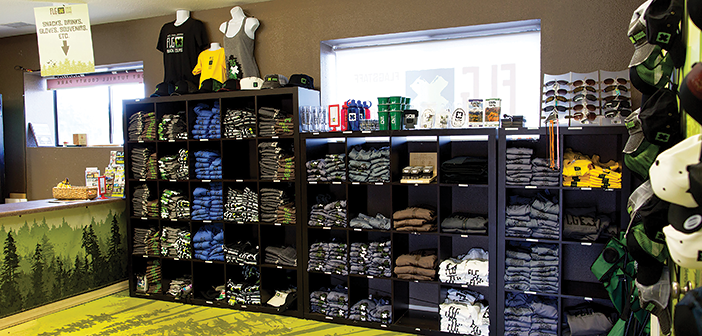Note from the Editors: Fall is the time of year to be looking at your ancillary revenue numbers and benchmarking your sales for next season. Check out the industry benchmark in the Adventure Park Insider State of the Industry Report and be sure to look for other alternative revenue source ideas in the Fall 2017 edition of the magazine.
Adventure park operators across the country are recognizing a variety of opportunities to help boost revenue in addition to the price of admission. By happy coincidence, these revenue boosters also help promote the park, canopy tour, or zip line. What is the key? Merchandising. Souvenirs and necessities, from hats and T-shirts to sunscreen and food, are both a customer service and a source of cash.
The low hanging fruit in this space is merchandising, with retail sales of T-shirts, hats, water bottles, and other take-home items—all properly branded with the park’s logo—being a popular, high-yield portion of the business. But operators who are most successful at garnering ancillary revenue go beyond the basics and find ways to capitalize on their particular situations.
MERCHANDISING SUCCESSES
“We are in a business where margins are tight and that little bit [of revenue]can make a huge difference,” says Jason Cohn, director of marketing at Hawaii Forest and Trail. So the company seeks to tap these other sources. “T-shirts are always going to be our best selling item,” he says. Guests often want a memento of their adventure, and T-shirts help publicize the park as well.
In addition to offering other standard logo items like water bottles and Croakies, Hawaii Forest and Trail rents and sells GoPro cameras and accessories. Guests are always eager to document their adventures, and carrying a strong brand like GoPro helps increase sales.
Cohn and his team also capitalize on their guests’ desire to document their visit by using FotaFlo, a digital photography service that specializes in adventure park images. According to Cohn, the service is easy to use and offers an additional revenue stream, as it allows visitors to purchase photos on-site. Guests can also share digital versions to social media, which provides a marketing benefit for the tour—the photos guests share are watermarked with the park’s logo. Cohn says the FotaFlo program, along with the GoPro merchandise, “are both big.”
While the immediate revenue is nice—some parks bring in as much as $100,000 with a service like FotaFlo— “The real value is in the marketing aspect,” says FotaFlo owner Ryan O’Grady. This far-reaching exposure is something that O’Grady says leads to increased visitation and ultimately more revenue for his clients.
MERCHANDISING BASICS
Once people walk through the door of your welcome center, having an efficient check-in space, a convenient way to purchase merchandise, and allowing people to move through the area without traffic jams are all factors that can impact revenues.
Conscientious layout helps with time and space management, according to Paul Kent, the owner of Flagstaff Extreme Adventure Course in Arizona. “Products are out in the welcome center where people can touch and see the merchandise,” he says. He notes that if merchandise is behind the counter, people are less apt to wait for staff to pull it down for them.
Kent also spoke to Flagstaff Extreme’s goal of giving customers an “external expression of their experiences.” Souvenirs and keepsakes provide participants with a more lasting experience that stretches beyond the activity, beyond the day, and gives them “something that they talk to other people about.”
At the same time, Kent is careful to provide his guests with a good value. For example, the park’s highest-volume item is a package that includes a water bottle equipped with a carabiner clip and a pair of gloves, which sells for just $6. Thanks to this package, Flagstaff Extreme expects to sell around 20,000 pairs of gloves this year.
How do you make sure you are stocking the right items? It never hurts to listen to customer requests. At Flagstaff Extreme, low-cost, high-yield collectible pieces, such as pins, magnets, sew-on patches, and shot glasses, have been added to the sales floor as a result of feedback from guests.
The park has also found success in offering grab-and-go food items, such as packaged granola and beef jerky, as well as fresh-made deli sandwiches on weekends. The most popular item on the menu? “We sell a ton of ice cream,” Kent says with a smile. Between retail, food, and beverage sales, Flagstaff Extreme expects an average spend of $10 per person.






